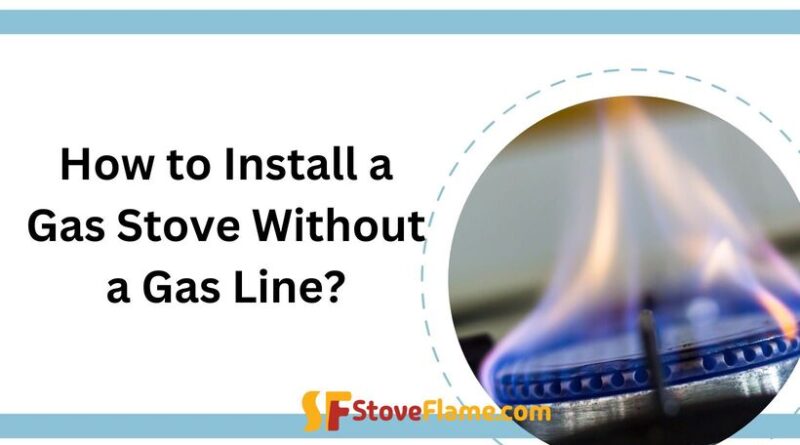How to Install a Gas Stove Without a Gas Line?
Installing a gas stove in your home can be a convenient and efficient way to cook, but it may seem daunting if you don’t have an existing gas line in your kitchen. However, with the right tools and knowledge, it is possible to install a gas stove without a gas line.
In this guide, we’ll outline the steps involved in installing a gas stove without a gas line. We’ll cover important safety precautions, required materials, and the installation process. Whether you’re a DIY enthusiast seeking a new project or aiming to cut costs on professional installation, this guide will equip you with the knowledge to tackle the task effectively. Let’s explore how to install a gas stove without a gas line.
What are Gas Stove and Gas Line?
Gas stoves are a common kitchen appliance that uses natural gas or propane as fuel to provide heat for cooking. They are popular due to their fast and efficient heat distribution, precise temperature control, and the ability to quickly adjust the flame intensity.
A gas line, on the other hand, is a pipe or conduit that carries natural gas or propane from the main supply to the appliance. It ensures a steady and safe supply of fuel to the gas stove. Gas lines should always be installed by a professional to ensure proper ventilation and adherence to safety codes.
Why May You Need to Install a Gas Stove Without A Gas Line?
Installing a gas stove without a gas line may be necessary in certain situations. For example, if you live in an area where gas lines are not readily available, or if you are remodeling your kitchen and want to relocate the stove to a different area where a gas line is not present, you may need to explore alternative options.
It’s important to note that this is not a recommended or standard practice, as it can pose safety risks and may not comply with local building codes. However, if you find yourself in a situation where installing a gas stove without a gas line is necessary, it’s crucial to consult with professionals who specialize in alternative fuel sources, such as propane or electric conversion, to ensure a safe and reliable solution for your cooking needs.
Understand Local Building Codes and Regulations
To ensure the safety and legality of any home improvement project, including installing a gas stove without a gas line, it is crucial to understand and adhere to local building codes and regulations. These codes are put in place to protect homeowners and ensure that construction and installations meet specific standards for safety and functionality.
Before embarking on any installation project, it is recommended to contact your local building department or code enforcement agency to obtain the necessary permits and to familiarize yourself with the specific requirements for installing a gas stove without a gas line in your area. By following these regulations, you can ensure that your project is completed correctly and safely, giving you peace of mind in your home.
How to Install a Gas Stove Without a Gas Line? (Don’t Do It Yourself)
When it comes to installing a gas stove without a gas line, it is highly recommended to hire a professional instead of attempting to do it yourself. A licensed and experienced plumber or gas technician will have the expertise and knowledge to safely handle gas connections and ensure that the installation is done correctly.
Gas lines require precise measurements, proper sealing, and compliance with safety regulations, which can be complex for someone without the necessary training. By relying on a professional, you can avoid potential safety hazards, such as leaks or improper ventilation, and have the peace of mind knowing that your gas stove installation is in capable hands. Remember, safety should always be the top priority when it comes to working with gas appliances in your home.
Safety precautions for gas stove installation without gas line
- Consult a professional
- Check local building codes
- Use proper tools and equipment
- Ensure proper ventilation
- Follow manufacturer’s instructions
- Have a fire extinguisher nearby
Common Issues When Installing a Gas Stove Without A Gas Line
When attempting to install a gas stove without a gas line, there are several common issues that can arise. One common issue is the lack of proper ventilation. Gas stoves require adequate ventilation to ensure the safe release of combustion gases. Without proper ventilation, these gases can accumulate in your home, leading to potential health risks.
Another common issue is improper sealing. Gas connections require precise sealing to prevent gas leaks, which can be dangerous and pose a risk of fire or explosion. Additionally, without the necessary experience, it can be challenging to accurately measure and install the gas line, resulting in an unstable or improperly functioning stove.
To avoid these common issues and ensure a safe installation, it is strongly recommended to consult a professional technician or plumber with expertise in handling gas connections. Their knowledge and experience will help minimize the risks associated with installing a gas stove without a gas line.
Safety Precautions
To ensure the safety of both your home and yourself, it is crucial to take certain safety precautions when installing a gas stove without a gas line. First and foremost, always ensure proper ventilation in the area where the stove will be installed. Adequate ventilation will help prevent the buildup of potentially harmful combustion gases.
Additionally, make sure to carefully inspect and seal all gas connections to minimize the risk of gas leaks. It is also important to have a fire extinguisher readily available in case of any emergencies.
The Verdict (Suggesting Hiring a Professional If Uncomfortable with the Process)
If you are uncomfortable with the process of installing a gas stove without a gas line, it is strongly recommended to hire a professional technician or plumber who is experienced in handling gas connections. Gas installations can be complex and require specialized knowledge to ensure proper installation and safety.
A professional will have the expertise to handle the gas connections, ensure proper ventilation, and inspect for any potential hazards. They can also provide valuable advice and guidance throughout the process. Hiring a professional may come with an additional cost, but it guarantees a safe and reliable installation, giving you peace of mind in knowing that your home and loved ones are protected.
I'm Daniel Miller, the proud owner of StoveFlame. With over five years of experience in this dynamic field, I've honed my skills and passion for delivering top-notch quality and accuracy in everything I do.





